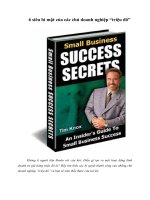Bí mật 7 đô la
Bạn đang xem bản rút gọn của tài liệu. Xem và tải ngay bản đầy đủ của tài liệu tại đây (181.96 KB, 33 trang )
www.7DollarSecrets.com
By Jonathan Leger
www.JonathanLeger.com
$7 Secrets 2
Table of Contents
1. Why Information Is the Perfect Product
You need to be selling information–here’s why.
2. Information is Not Problem Free
Information’s four main problems.
3. The $7 Secrets Method
How the $7 Secrets method solves information’s problems.
4. Why $7 is More than $7
How I made $3,000 in 7 days selling a 30 page report.
5. Why Super Affiliates LOVE to Promote These $7 Reports
My affiliates sent 17,785 visitors in the first six days.
6. Putting It All Together
The five-step summary of my $7 Secrets method.
7. The Fastest, Easiest Way to Sell $7 Reports
Download the scripts I use to make it a breeze–free!
8. Why You Must Have Virtual Covers For Your Reports
Virtual covers dramatically increase sales.
9. Make Money With This Report
Earn back your $7 times 10, 100, or 1000–in minutes.
10. About the Author
$7 Secrets 3
Why Information is the Perfect Product
You need to be selling information–here’s why.
For over a decade now Internet Marketers have been touting the wonders of selling
information to people. I’m here to tell you–they were all right! I’ve been selling
information for a few years now, and earning many times more than my old day job used
to pay (and the amount I earn goes up every year).
Information is the perfect product for three reasons:
1. It’s easy to produce.
2. It’s inexpensive to produce.
3. It can be immediately received.
Information Is Easy To Produce
Informational products are very easy to produce if you already have some knowledge on
a subject that is considered valuable by others. Fortunately, given the huge diversity
across the web, it’s hard to come up with an informational topic that is not of value to
somebody.
For example, if you want to write a report on how to save money on your taxes, and
you’ve been working for the IRS for ten years, then it’s just a matter of organizing what
you already know and laying it out into a report.
$7 Secrets 4
Or, if you’re a plumber and you are always running into problems with certain kinds of
products, you can write a report detailing the best shower heads, faucets, toilets, sinks,
etc. to buy when building or remodeling a new home. Again, you already have the
knowledge. It’s just a matter of organizing it into something useful to other people.
To produce this knowledge, you may find it helpful to come up with a table of contents
first. Then just flesh out each chapter into a few pages. Or you might find it easier to
simply start typing your knowledge out into your favorite word processor. When you’re
done, you convert the document into a PDF file using free tools and you sell it. Sounds
easy, right? Well, it’s a bit more involved than this paragraph makes it sound, but yes, it
is rather easy to do. Certainly easier than creating a “brick and mortar” product.
Here’s a great site for finding out what kind of topics people are interested in reading
about. This site has laid out goals and tasks for a large variety of things (like losing 10
lbs or learning to play golf, etc.). The information is almost perfect for building reports
around, and the site has lists showing popular goals (read: what’s marketable).
/>Here’s the software I use to convert documents to PDF files for free. It doesn’t matter
what Word Processor you use, since it installs as a printer and you just “print” to it.
/>$7 Secrets 5
Information is Inexpensive to Produce
This really goes hand in hand with what I’ve already said. If you already have the
knowledge, getting the information into an organized format really only requires time.
Even if you don’t have all of the knowledge you need, doing research online to fill in the
holes is also very inexpensive–usually free.
However, just because it’s inexpensive to create the informational product doesn’t mean
that the information itself is not very valuable. There’s not a How-To book written in the
world that contains information you can’t get for free somewhere else. The question is:
how long would it take you to find it all? People buy How-To books because they want it
all in front of them in a nice, easy package. That’s why informational products sell so
well.
Information Can Be Immediately Received
Another one of the reasons that informational products sell so well is because the visitor
reading your sales page knows that the product will be immediately received. They
don’t have to go shower, get in the car, and take a trip down to the bookstore to get the
information. They don’t even have to wait for Amazon.com to ship it to them after they
ordered it online. No, they will get it right now. That’s a big selling point for a lot of
people.
$7 Secrets 6
Plus, it’s easier on you as the creator of the product. You don’t have to pay a printer to
print the books. You don’t even have to burn CD’s. There’s no shipping to do, either.
It’s much less expensive, and a lot less hassle, than traditional informational products
like books.
Don’t Look Now, But…
Yes, information is definitely the best thing to sell online–but it’s not problem free: at
least, not the way most people are trying to sell it. The next section discusses these
problems.
$7 Secrets 7
Information Is Not Problem Free
Information’s four main problems.
Yes, informational products are the best products to sell, especially online. However,
that does not mean that there are not some real problems involved in trying to sell them,
especially now when the idea has caught on and competition is growing fast.
Informational products can been problematic for four reasons:
1. You have to convince people of its value.
2. You have to price it right.
3. Refunds, refunds, refunds.
4. You have to have a good sales team.
You Have to Convince People of the Value
Is information valuable? Of course, everybody knows that. People buy books, watch
the news, read newspapers and magazines–all which they (or somebody else) had to
pay for. They’re willing to spend the money because they know that information is
valuable.
Is digital information valuable? Again, of course it is. However, because people aren’t
getting a physical product, it takes more work to convince people of its value.
$7 Secrets 8
For example, with a book or a magazine, a person can pick it up on the stand at the
store and flip through its pages. They can see what it contains and read parts that are
of interest to them in order to make the decision of whether or not the information is
worth buying.
You can’t do this with digital information like PDF reports or ebooks. People can’t flip
through the pages. If you give them a copy to look at ahead of time… well, let’s just say
that’s not a good incentive for them to come back and pay.
So you need a sales letter that really demonstrates in convincing language how
valuable the information contained in the report or ebook really is. Unless you’re a
skilled copywriter (or like me, an individual who’s had a lot of practice and beat his head
against a lot of digital brick walls), it can be hard to provide a strong enough sales pitch
to get people to pay $47, $67 or even $97 for an ebook.
That brings me to the next problem with digital information products.
You Have to Price Them Right
Yes, digital information has value, but you can’t put it on the shelf. It won’t one day be
really valuable just because it’s really old. You can’t snap it up for a quick browse while
you’re waiting at the doctor’s office. So that puts questions in potential customer’s
minds about how much they are willing to pay for your information.
$7 Secrets 9
Let’s assume that your sales letter has convinced them that they would benefit from the
information you have to offer. That’s a great first step. But you also have to convince
them that it’s worth the price-tag you’ve put on it.
If you’re trying to sell an information product for $47, $67 or even $97 (and many of
them are priced that way), it can be tough to achieve a good conversion rate. This is
especially true if you have competition who’s willing to work “on the cheap”, slashing
their own prices for similar information. Yours might be better, sure, but it’s hard to
convince people of that sometimes–remember, they can’t flip through the book first.
Refunds, Refunds, Refunds
The plague of over-priced digital informational products is the refund request. Since
people aren’t getting a physical book, they expect a lot of value in what they download
to read. They demand an info-packed PDF that will really bring home the bacon.
If you fail to deliver, you will receive refund demands left and right. It’s hard enough to
convince somebody that your information was worth $47, $67 or $97, but once you’ve
convinced them it is, it’s even harder to keep them convinced so they don’t request a
refund.
$7 Secrets 10
You Have to Have a Good Sales Team
If you’re going to sell digital products, you need a generous affiliate program, one that’s
reliable and has good terms. You might have the best product in the world, but making
it take off all on your own, without the benefit of a strong sales force, is very hard and
expensive.
You want to be generous with your affiliates, but you still want to make money yourself
while not setting the price so high that the conversion rate plummets. That’s not an
easy balance to strike, especially if you’re new to the world of producing and selling
informational products.
There’s A Better Way
The purpose of this report is to teach you a solution that takes advantage of all of the
great aspects of informational products while minimizing the problems. The traditional
methods of producing a product and selling information online are getting much harder
because of competition–but it doesn’t need to be hard.
In the next couple of sections I’m going to discuss a better method, the $7 Secrets
method, that I’ve formulated to make it a lot easier to earn a living through creating and
selling digital products online.
So read on!
$7 Secrets 11
The $7 Secrets Method
How the $7 Secrets method solves information’s problems.
What can you buy for seven dollars? A fast food dinner for one person, two magazines
off the rack, a few gallons of gas. You buy all kinds of things, probably every day, that
cost about seven dollars. You probably don’t give it a second thought. You just buy it,
use it, and throw it away.
Why? Because seven dollars isn’t a lot of money, not to most people. At least, not to
most people who can afford a computer and an Internet connection. That’s the beauty
of the $7 Secrets method of producing and selling information products: if the person
has the means to be looking at your sales letter, chances are they can afford to pay
seven dollars for the product! This method also takes away the first three of the four
major problems with information products:
1. It’s easy to convince people to pay seven dollars for a product.
2. The price is just right for most people’s pocketbooks.
3. Refunds are virtually non-existent.
And there’s an added fourth reason for only charging seven dollars:
4. There’s virtually no support required for the product.
Let’s go through each of these points one at a time.
$7 Secrets 12
Convincing People Your Product is Worth $7 Is Easy
I love bookstores. Yes, I’m a programmer, and yes, I create (and buy) digital
informational products all the time–but I love bookstores. I go to my local Barnes ‘n
Noble all the time. I almost always buy something while I’m there–but I don’t always buy
something expensive.
I put thought into buying a book that is more than fifteen or twenty dollars. I think about
whether or not I really need it, or if it’s good enough to spend that much. I examine the
table of contents, flip through the pages, and really consider it.
This is especially true if the book is priced in the fifty dollar or more range. It’s a rare
book that holds that kind of value for me. When I find them, I love them, but that
doesn’t happen very often.
That’s how most people are, isn’t it? We’ll drop ten (or seven) dollars on just about
anything without giving it a second thought, so convincing us that something’s worth that
much isn’t hard to do. That’s because it’s not a big risk. Ask for much more than that,
though, and we start thinking about whether or not it’s worth it.
Salesmanship is all about taking away the risk from the buyer. That’s why so many
products have money-back guarantees. People want to feel safe when making a major
purchase. Not so with a seven dollar product. Most people don’t consider losing seven
dollars to be a risky investment.
$7 Secrets 13
Because of this, your sales page copywriting abilities don’t have to be stellar when
you’re charging only seven dollars for your informational product. You don’t have to
wow the visitor with a huge list of “bonus” gifts to get them to buy. You don’t have to get
the wording just right or have a hundred testimonials splashed across the sales page.
In fact, your sales copy can be pretty short. My first seven dollar report sales page was
less than a thousand words long–I’ve written articles longer than that! Compare that to
22,000+ words on Joel Comm’s recent sales page for his Monthly Templates product.
Why so long? Because he’s selling an expensive product, so it takes a lot of convincing
to get people to buy.
Now, I don’t know Joel’s conversion rate, but I got a 15% conversion rate on my report
when I promoted it to my own list. My first wave of affiliates had a 10% conversion rate.
Now, the overall conversion rate for my affiliates is near 7%. What are your conversion
rates like? Want them to improve? Then charge seven dollars for your product.
A $7 Price-Tag Prevents Refunds
Selling an informational product for seven dollars also prevents refunds. As I said
earlier, when your price is high, the demand on your product is very high. People want
a three hundred page ebook for $97, and it better deliver the goods! If it doesn’t, you
can expect a lot of refunds–not to mention that the customer will never buy again.









